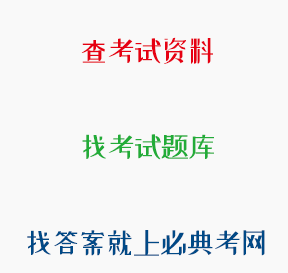正确答案: A
永恒性
题目:教育是新生一代成长与社会生活延续和发展不可缺少的手段,为一切人和一切社会所必需,并与人类社会共始终。这表明教育具有( )。
解析:教育的社会属性包括永恒性、历史性、相对独立性、生产性、民族性。永恒性指教育是人类特有的社会现象,只要人类社会存在,教育就存在。题干表明教育具有永恒性。历史性指在不同的社会或同一社会的不同历史阶段,教育的性质、目的、内容等各不相同,每个时期的教育具有自己的特点。
查看原题 查看所有试题
学习资料的答案和解析:
[单选题]测验达到测验目的的程度,称为( )。
效度
解析:效度是指一个测验或测量工具能真实地测量出所要测量的事物的程度。一次测验是否有效,主要看其是否能准确地测量所要测量的东西。故选择B。A选项,信度是指测验结果的稳定性或可靠性,即某一测验在多次施测后所得结果的准确性、一致性程度。C选项,区分度是指测验对考生的不同水平能够区分的程度,即具有区分不同水平考生的能力。D选项,难度是指测验包含的试题难易程度。
[单选题]动作技能形成过程中有一个明显的、暂时的停顿现象,心理学上称为( )。
高原期
解析:"高原现象"是指在学习或技能的形成过程中,出现的暂时停顿或者下降的现象,中间的明显的、暂时的停顿期,即高原期。
[单选题]Passage 1
Today's adults grew up in and economic system. The amount of time available to learn was fixed: one year per grad amount learned by the end of that time was free to vary: some of us learned a great deal;some, very little. As we advanced through the grades,those who had learned a great deal in previous grades continued to build on those foundations. Those who had failed to master the early prerequisites with in the allotted time failed to learn that which followed. After 12 or 13 years of cumulative treatment of this kind, we were, in effect, spread along an achievement continuum that was ultimately reflected in each students rank in class upon graduation.
From the very earliest grades, some students learned a great deal very quickly and consistently scored high on assessments. The emotional effect of this was to help them to see themselves as cap-able learners, and so these students became increasingly confident in school. That confidence gave them the inner emotional strength to take the risk of striving for more success because they believed that success was within their reach. Driven forward by this optimism, these students continued to try hard, and that effort continued to result in success for them. they became the academic and emotional winners. Notice that the trigger for their emotional strength and their learning success was their perception of their success on formal and informal assessments.
But there were other students who didn't fare so well. They scored very low on tests, beginning in the earliest grades. The emotional effect was to cause them to question their own capabilities as learners. They began to lose confidence, which, in turn, deprived them of the emotional reserves needed to continue to take risks. As their motivation warned, of course, their performance plummeted These students embarked on what they believed to be an irreversible slide toward inevitable failure and lost hope. Once again, the emotional trigger for their decision not to try was their perception of their performance on assessments.
Consider the reality--indeed, the paradox--of the schools in which we were reared. If some students worked hard and learned a lot, that was a positive result, and they would finish high in the rank order. But if some students gave up in hopeless failure, that was an acceptable result, too, because they would occupy places very low in the rank order. Their achievement results fed into the implicit mission of schools: the greater the spread of achievement among students, the more it rein-forced the rank order. This is why, if some students gave up and stopped trying(even dropped out of school) that was regarded as the students problem not the teachers or the school's.
Once again, please notice who is using test results to decide whether to strive for excellence or give up in hopelessness. The "data-based decision makers"in this process are students themselves Students are deciding whether success is within or beyond reach, whether the learning is worth the required effort, and so whether to try or not. The critical emotions underpinning the decision making process include anxiety, fear of failure, uncertainty, and unwillingness to take risks all triggered by students' perceptions of their own capabilities as reflected in assessment results.
Some students responded to the demands of such environments by working hard and learning a great deal. Others controlled their anxiety by giving up and not caring. The result for them is exactly the opposite of the one society wants. Instead of leaving no child behind, these practices, in effect,drove down the achievement of at least as many students as they successfully elevated. And the evidence suggests that the downside victims are more frequently members of particular socioeconomic and ethnic minorities.
Passage 1
Which of the following will be triggered by the assessment results according to the passage?
Students' learning efforts
解析:由倒数第二段可知,根据考试结果决定继续努力还是放弃的是学生自己,在做此决定的过程中的重要情感都是由学生对于自己在考试中反映出的能力的态度所决定的。故选择A。
[单选题]技能的学习最基本的条件是( )。
练习
解析:练习是形成各种操作技能所不可缺少的关键环节,是动作技能形成的基本条件和途径。所谓技能,一般认为是通过练习而形成的合乎法则的活动方式。一般来说,随着练习次数的增多,动作的精确性、速度、协调性、灵活性都会逐步提高。故选择C。AB选项,示范、讲解是技能训练的第一步,准确的示范与讲解有利于学习者在头脑中形成准确的定向映像,进而在实际操作活动中调节动作的执行。一般来说,教师的示范要注意整体示范与分解示范的结合,并且注意示范时速度的控制。D选项,反馈是指在学习者知道自己的学习结果后,据此对其学习方法、计划和目标作出相应的调整。反馈对技能的顺利掌握有着重要的意义,研究表明,从结果中获得的反馈越多,练习的进步就越快。

 川公网安备 51012202001360号
川公网安备 51012202001360号